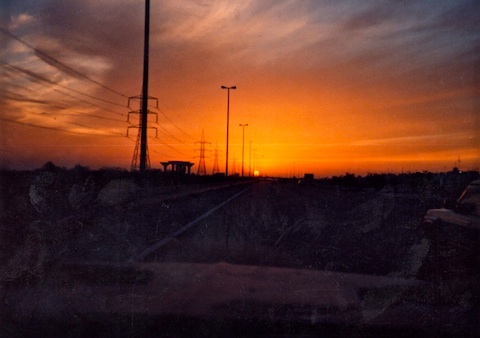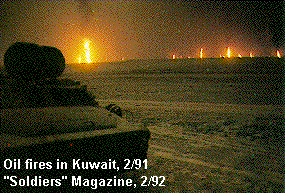By SSgt. Larry Lane
Soldiers
February, 1992
Repairing Kuwait’s parliament was one way
soldiers helped the desert nation recover
from war’s devastation …
Just a few days after the Persian Gulf war ended, a U.S. Army Corps of Engineers convoy of vehicles crossed the Saudi Arabia-Kuwait border, and damage assessment began.
Kuwait was a minefield of unexploded ordnance. The country was shrouded in the smoke of smoldering facilities and oil wells set ablaze by fleeing Iraqi soldiers. Buildings were “bunkerized” with concrete blocks walling up every window.
Destroyed military vehicles and stripped cars choked the roads. Downed power lines spider-webbed across the darkened country. The rubble of war became worse as the team reached Kuwait City.
Night passed with little notice in those days, as the coal-black sky blocked the sun. The streets were empty, save for Kuwaiti resistance fighters manning checkpoints haphazardly set up at intersections.

“There was not one light in the country,” the Corps’ Kuwait Emergency Recovery Office (KERO) commander. Col. Ralph Locurcio said about his first day in Kuwait, March 4. “The sky was black, and it was raining.
“I remember watching the movie ‘War of the Worlds,”‘ Locurcio said, recalling H.G. Wells’ dismal vision of the future. “Coming into Kuwait City reminded me of that.”
It was a ghost town. Only about 260,000 jubilant but apprehensive Kuwaitis remained in the city from a pre-war population of 2.2 million.
The first mission for the Corps of Engineers emergency team was to get essential services — water, electricity and sanitation — back on line. Govemment buildings, hospitals, electric plants and other essential facilities had been targeted for destruction by Iraqi forces.
With the help of the 535th Power Detachment of the 416th Engineer Command, a reserve group from Chicago, and the 352nd Civil Affairs Brigade, emergency needs were met. Power was restored to hospitals, police facilities and fire stations. Food and water distribution centers were established.
After re-establishing basic services, Corps engineers and the newly-established Defense Reconstruction Assistance Office continued the seemingly endless task of assessing the war damage. A handful of contracts had been awarded before the team’s journey to Kuwait. They covered the initial repairs needed to get the city through the first 90 days.
Locurcio said the Corps had little recent wartime experience on which to base its Kuwait emergency assistance planning. The last war to study for examples was World War II. However, the Corps has more recent experience in natural disaster response and was able to use that information to plot a course of operation.
Fifty Kuwaiti volunteers assisted the Corps as translators, giving directions and explaining the unique traits of Kuwait’s systems.
After the emergency phase, the Corps shifted into a recovery and repair phase, “from patching to actual repairs,” Locurcio said.
The Corps’ task was to repair those areas which the Kuwait government identified as essential for Kuwait to continue on the path of reconstruction.
Electricity, water and sanitation topped the priority list. The lights went out on Feb. 23 after the power stations were damaged or destroyed and lines were downed. Almost exactly one month later electricity was restored, and one year later most of Kuwait City has power.
All of the desalination plants were inoperable, and two billion-gallon reservoirs were emptied. Water is available to all of Kuwait City now. Three of the four plants are producing 110 million gallons per day, and the reservoirs are full.
Three major sewage treatment plants were inoperable. Raw sewage flowed into the gulf. Repairs to all of the stations have been made, and the facilities are on line again. Repair work on a downed electric tower is complicated by cluster bombs scattered about the desert.
Unexploded ordnance, from both Iraqi sabotage and allied bombing, hampered early repair work. One year later, cluster bombs and other ordnance still impede the restoration of water and electricity to areas farther away from the city. Pat Douglas, resident engineer with the utilities and transportation office, said the explosive leftovers of war are perhaps the biggest problems facing the crews.
“The electric lines run through minefields, over ordnance-laden bunkers, and through diesel oil trenches,” he said. “We work through fields of Rockeye cluster bombs and other bombs.”
The Kuwait government identified the importance of repairing the many damaged schools to allow the children to return for the new school year. Many children missed school throughout the Iraqi occupation.
Iraqi soldiers had used the schools for command headquarters. The large classrooms were perfect for housing soldiers. Each school is surrounded by an eight-foot high concrete wall, providing a natural fortification. All the soldiers had to do was brick in the windows to create a fortress.
Harold Hartman, buildings resident engineer for the Corps, said the damage to the school system did not surprise him as much as disgust him.
“I would find a crayon drawing or a sheet of paper where a child had practiced writing, and they would be scattered on the floor.” Hartman said. “There would be a big soldier’s footprint on it.”
Hartman thought of his children safely in the U.S. He knew that the schools would have to be repaired quickly. “Schools are an integral part of any community and affect the fabric of the country,” he said.
To get the school work started quickly, the Corps used “unpriced change orders.” These orders are appended to existing contracts so that contractors can begin work immediately. Corps inspectors and managers then “detail” and control repairs as work progresses. This procedure is typically used by the Corps during natural disaster recovery operations.
This method saved hours of drawing up specific contracts, and by June, the repairs were being made. Eager parents often pitched in, clearing classrooms of trash and painting graffitied walls.
Parents were especially concerned about explosives left behind. Several U.S. explosive ordnance disposal teams remained behind after the war; they shifted efforts to assure a safe working environment for contractors and for the returning children. When the classrooms opened Aug. 26, 146 schools were complete.
Kuwait’s military facilities took the worst hits, through Iraq’s malicious destruction and by allied bombing to oust the Iraqis from their positions.
Even though Ash Wahba, resident engineer of the Defense Resident Office, assisted in a typhoon destruction project in Okinawa, he had never seen such a “monumental task” as repairing the destroyed military sites. “Just the cleaning of it,” he said, “has taken hundreds of thousands of dollars.” When at the sites, Wahba often finds Kuwait military personnel viewing the area.
“They are appalled and show us where their offices were,” he said. Most of the military buildings will have to be rebuilt, adding years to the recuperation.
Repairs to civil infrastructure continue through the Corps’ KERO, with the remaining work expected to be completed this spring. Repairs to Kuwait’s two air bases will then be managed by the Corps’ newly-established Kuwait Program Office.
The greatest economic and environmental damage resulted from the many hundreds of burning oil wells. The forecast was bleak in March 1990, and estimates said the last well fire would be put out in two years. But a coalition of firefighting teams from throughout the world joined the fight, and the last fire was snuffed out Nov. 6, 1991.

The emergency is over, and one year after liberation, Kuwait’s future is looking much brighter. The luster is beginning to return to the country, once considered the “Jewel of the Gulf.”
Though little of the destruction remains visible within the city limits, “We still have thousands of ‘gremlins’ from the Iraqi occupation,” Locurcio said. Gremlins are what he calls the hundreds of smaller systems damaged during the occupation. “We have elevators that don’t work and ‘four-way green’ traffic lights. They impede progress, create hazards and make life difficult.”
These inconveniences will eventually be taken care of, but the horror of the Iraqi occupation will long remain in the memories of the Kuwait people. “The war is over, except for the POWs,” Locurcio said. “Kuwait will live with this lingering memory of pain and terror for years to come.”
| Task Force Reshuffling Refugee Camps | Life Returns to Kuwait | Turkish Parliament Extends Provide Comfort Mandate |
